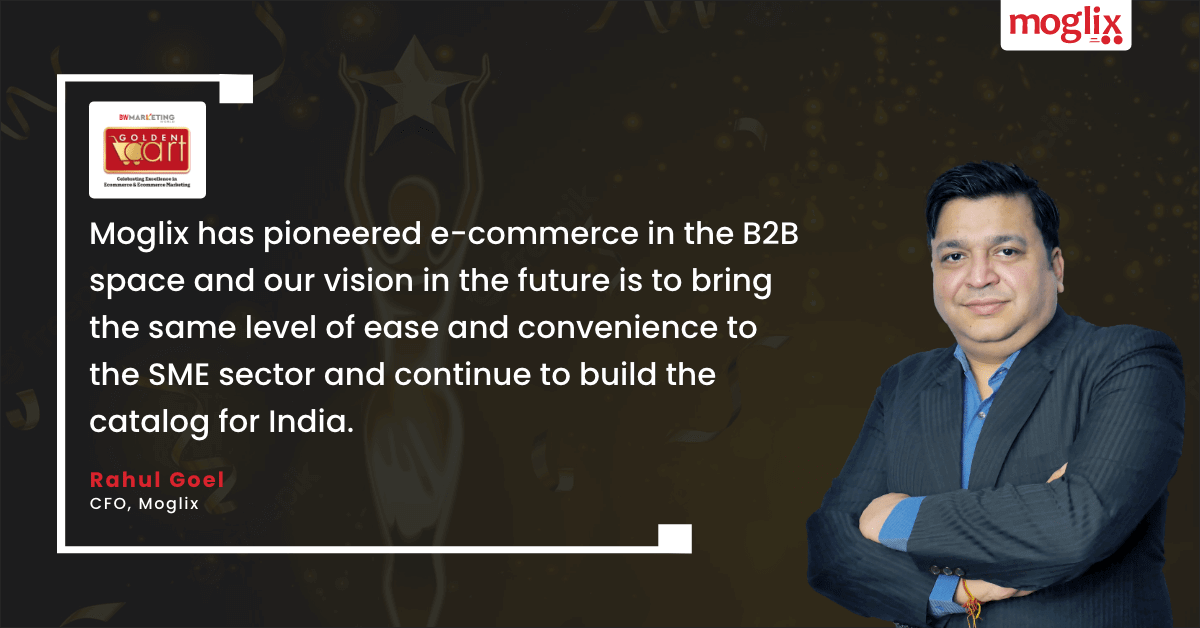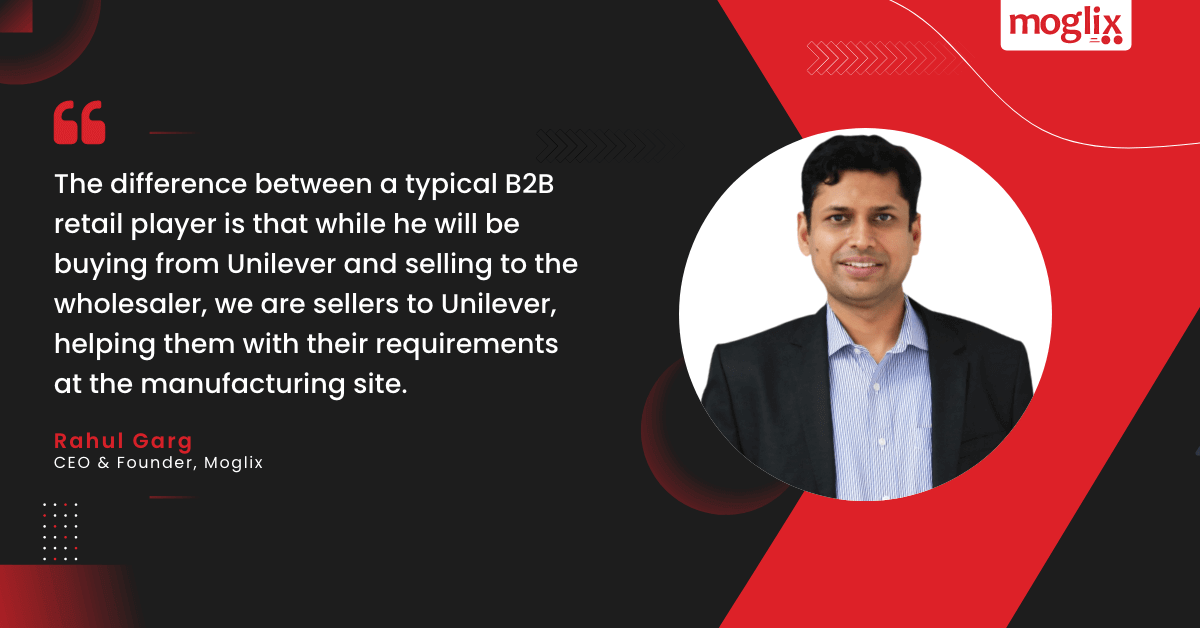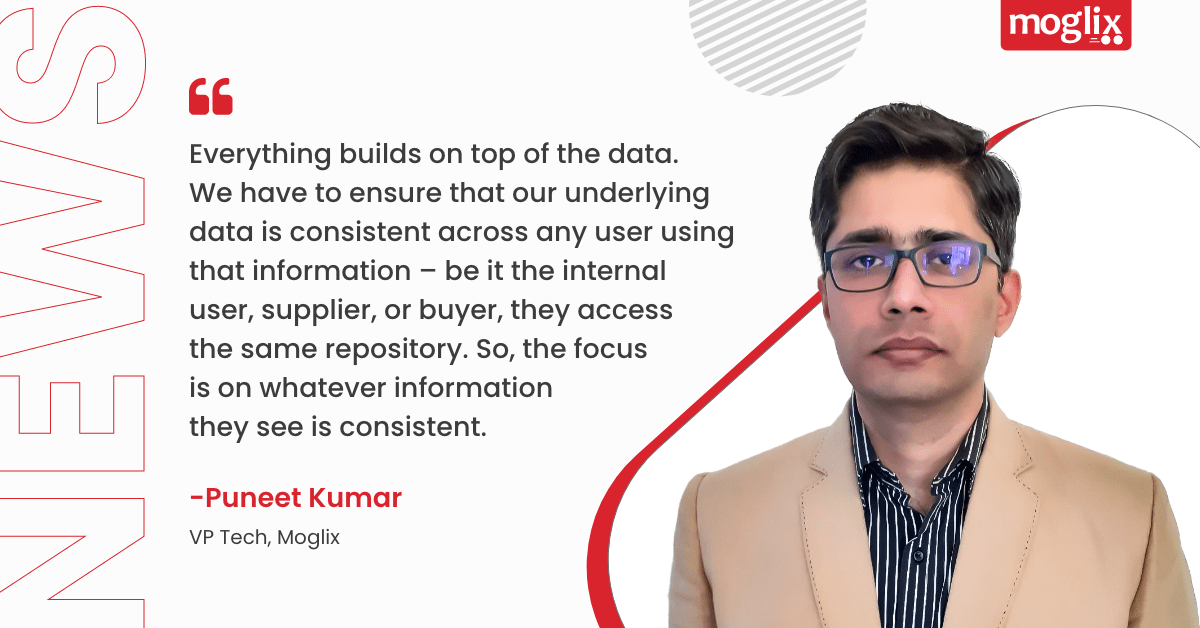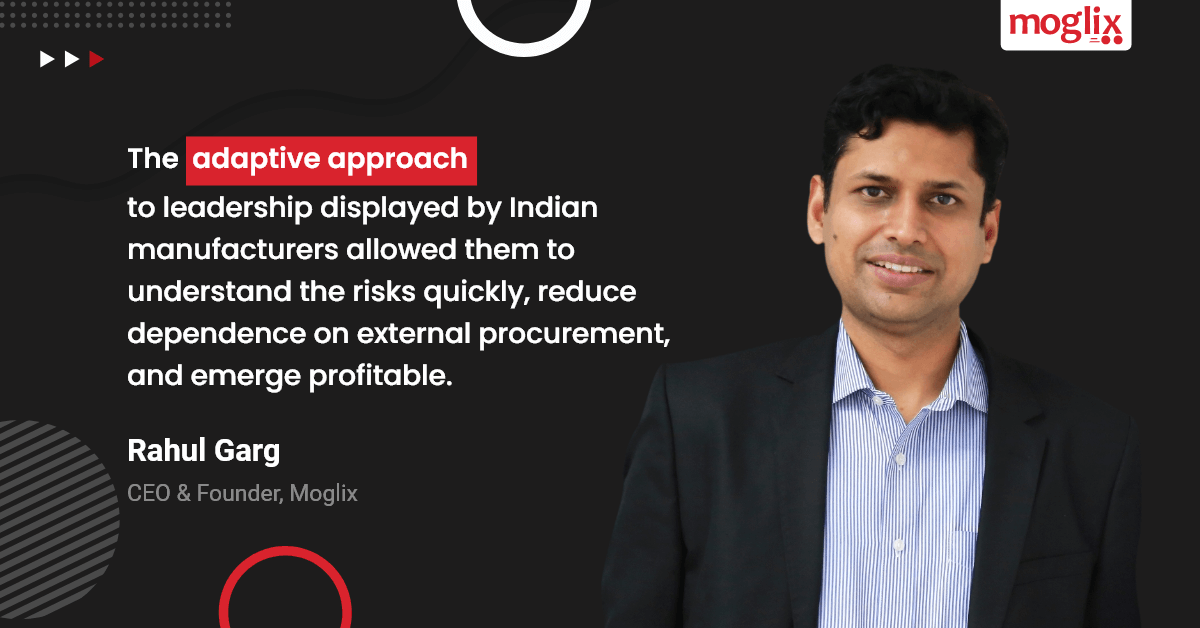Pioneering B2B e-commerce and Supercharging SME Growth

Pioneering B2B e-commerce and Supercharging SME Growth
Moglix is the first industrial B2B e-commerce platform to enter the unicorn club. Set up in 2015, we have grown at 500% for three consecutive years now. With 7 lac SKUs across 50+ categories of MRO spanning a price range of INR 50 to INR 1 crore, Moglix offers the largest and widest range of industrial goods in India.
We pioneered GST compliant e-invoicing required for audit trail and input tax credits at all levels in the B2B supply chain. We have enabled RFQ placing for getting quotes on bulk procurement. We also offer consultative selling for customers to improve performance and reduce product costs and the total cost of ownership. We enable suppliers to promote their brands and build equity with MSMEs and direct customers, offering discounts and product updates for customers under our loyalty program.
In the last 6 years, we have grown four to five times in terms of top line. We have enrolled 5,00,000 MSMEs and 16,000 suppliers into India’s digital economy and created jobs for our 1000 strong workforce. We have 35 locations in India, Singapore, UK and Middle East and we have expanded our global sourcing portfolio to a very large extent. We believe that India will be going through the same rush in the B2B e-commerce segment as the B2C segment. With deeper penetration of smartphones among rural and suburban users and digital financing, India has an opportunity to revel in the benefits created by the digital economy. In the next 5 years, we are looking at a 20X growth of the SME business.
Abheet Dwivedi, Senior Director, Moglix, Speaks on the Future of Infra Supply Chain in India

Abheet Dwivedi, Senior Director, Moglix, Speaks on the Future of Infra Supply Chain in India
“With the inception of the National Infrastructure Pipeline, India’s investment in the infrastructure sector as a percentage of the GDP is now at 8.5%, which is quite phenomenal when you look at historical trends of our infra spending.”
Abheet Dwivedi, Senior Director, Infra & PSU
Moglix is into the supply of materials; every material that is needed in the infra value chain. Abheet Dwivedi, Senior Director, Infra & PSU was in conversation with ET Infra for the podcast “The Future of Supply Chain in India”. During the conversation, Abheet Dwivedi shared his perspective on a range of questions concerning the infrastructure industry vertical and how Moglix is disrupting the infrastructure supply chain space for EPC companies with a unique offering of a digitally integrated suite of supply chain solutions. Here are the excerpts of the conversation:
Interviewer: So, let me begin by asking you about the long-term spending by the infrastructure companies say in the next five years under this national infrastructure pipeline, what do you make of this?
Abheet: Thank you…. So, firstly, if you look at historical spend perspective, from the 2000 onwards all the way up almost 2016 -17. With the NIP, national infra pipeline coming into the picture, this spend has actually more than doubled to in the current budget to almost 3.5%. we are spending close to eight and a half percent of our GDP on infra which is quite phenomenal compared to the levels we had historically seen….
Interviewer: And what about the digital project management under the ambitious PM Gati Shakti plan, which was unveiled by the Prime Minister in October?
Abheet: ….One thing that has historically been missing is “how efficiently are we spending the infra budget”, right. We have started measuring this more coherently now. I would like to mention four major initiatives….
Moglix Set To Take a Big Leap, Tap Bigger Opportunities

Moglix Set To Take a Big Leap, Tap Bigger Opportunities
‘Moglix’ may sound like an unusual name for a company. But if you suspect that it has been derived from the iconic character in Rudyard Kipling’s Jungle Book, you will have scored ten on ten. The founder of the Noida-headquartered start-up, Moglix, dealing with regular supplies to enterprises, infrastructure projects and now also supplying chain financing (basically B2B retail play) is clear in his mind: his business should eventually have the universal appeal of a character like Mowgli.
“It had taken me more than two months to finalise this name. I was looking for a name which can readily establish our brand identity. Alibaba and Google are great brand names. And everybody knows Mowgli,”
Rahul Garg, CEO & Founder, Moglix
Since the beginning of its journey in 2015, the company has been in the news for having the legendary Ratan Tata supporting it individually as an investor which Garg says has been a huge blessing.
As Moglix grows in age, its future leaps is getting higher. The company recently saw its valuation more than doubling as it touched $2.6 billion after Series F funding around the end of January when it raised a further $250 million (a total of $470 million has been raised since its inception). Starting mainly with tools and equipment suppliers to industries and manufacturing units, the company has significantly broadened its portfolio over the years and today boasts of over 700,000 SKUs in 50-plus categories across MRO, packaging and infrastructure. It has over 5 lakh SME units as part of its ecosystem and it manages 35 warehouses across the country.
“70-80 per cent of our backend logistics requirements is taken care of by our own team. We partner with players outside of the company mainly for long-haul transportation,”
Garg adds
Claiming complete ownership of the source-to-site supply chain for EPC construction projects and business, it serves some of the largest infrastructure and construction companies, energy companies, and oil & gas producers.
“We decided to launch the vertical in 2020 because of the demand from customers. Most infrastructure sites are geographically dispersed and in non-metro locations. The firms working in those locations want reliable partners for the regular needs of their engineering and design teams working on site,”
Abheet Dwivedi, Director (Infra & PSU), Moglix
Meanwhile in July last year, Moglix also ventured in a new direction to further endear itself with manufacturing customers when it acquired Vendaxo (founded in 2017), an e-commerce platform for the buying and selling of used machinery. According to a company note, Vendaxo is a B2B e-commerce platform that provides used machinery liquidation solutions to MSMEs and large manufacturing enterprises such as Siemens, Arvind India, Marico, Raymond, and Torrent Pharma. India’s used machinery market is estimated to be worth close to Rs64,000 crore.
Connecting to New Growth Opportunities: The Gorakhpur Link Expressway

Connecting to New Growth Opportunities: The Gorakhpur Link Expressway
Packing a punch within a 91 km expanse, the Gorakhpur Link Expressway will have a total commercial outlay of INR 5876 crore. The expressway will connect the Gorakhpur district to the Purvanchal Expressway in Azamgarh district.
UP Government’s 3rd Major Infrastructure Development Roadway:
The Gorakhpur Link Expressway is the third announcement after the Ganga and Purvanchal expressway road projects announced by the state government in recent years. Clearances and inauguration were approved in 2018, and by January 2022, more than 50% of the earthwork had already been completed.
The chosen contractors (Apco Infratech and Dilip Buildcon) will build the expressway according to the Engineering, Procurement and Construction (EPC) model. It is expected to improve ground connectivity between Gorakhpur and Azamgarh and reduce travel time to less than 5 hours. The Gorakhpur link expressway will be linked with Varanasi through a separate link road in the future.
A Stellar Addition to An Ever-Impressive list of National Infrastructure Projects (NIP) in India:
The project is completely access controlled and will have relief service roads for local transport. It is expected to cover two toll plazas, three ramp plazas, 27 minor bridges, more than 50 vehicular underpasses for light vehicles, 16 vehicular tunnels and more than 30 pedestrian underpasses.
Highway to Economic Inclusion and MSME Growth:
The project was in danger of being severely delayed by the Covid19 pandemic and labor and supply chain issues caused by the two phases of the lockdown. However, through better planning and extraordinary efforts by the contractors, the project is expected to regain lost time to achieve its previous completion targets. The environmental footprint by reduced travel time and distance is enormous. It will also provide much-needed logistical relief to many industrial training and medical institutes expected to be built along the expressway.
Contractors dealing with a high complexity layer of suppliers for raw materials, expected delays, lockdowns and labor issues would do well to digitize their procurement backbone through a centralized platform for better visibility and predictability.
A Digital Procurement Solutions Approach for New-Age Contractors:
As one can imagine, a project of so many moving parts needs intense coordination in procurement and the supply chain of raw materials. A single missing link in the chain results in labor inefficiency, time delays and a bloated budget. Some key takeaways for contractors and suppliers to usher in a transformation in crucial infrastructure projects:
- Adopt a flexible, reliable and digital procurement solution to reduce the PR to PO cycle. A slight reduction in the time cycle can have a lasting impact on costs.
- Digital procurement enables end-to-end flexibility and transparency of the procurement chain, involving many materials like TMT bars, cement plates and ready mix concrete.
To know more about how an EPC solution can work for your construction or infrastructure project, reach out to Moglix. Explore the best raw material procurement solutions for infrastructure companies. Click here to know more: https://business.moglix.com/our-solutions/infrastructure
Leveraging Cloud and Data Science to Manage Demand Spikes

Leveraging Cloud and Data Science to Manage Demand Spikes
Noida-based Moglix has played a pivotal role in transforming B2B commerce since its launch in 2015. Having achieved the distinction of becoming the first unicorn in the industrial B2B commerce platform in the manufacturing space, the company is experimenting with a slew of technologies to manage data and the spikes between the business cycles while providing a consistent user experience.
“If you look at the 100% of the orders that we process in a month, the first half of the month is slightly leaner, where we would do about 25% of the transactions. Maybe in the next five days, we will do an additional 25%, and during the last 5-10 days, a big chunk of transactions will occur,”
says Puneet Kumar, VP Tech, Moglix
“There is much information moving to and fro between systems, and a lot of them are financial in nature, having very core data from the customer side, the supplier side. So, there is much focus on the security of the systems we take care of really well. As we start transacting with more and more businesses, the volume of data that we are storing is also going up. So, again, efficient cloud models will enable us to scale up those demands,”
Kumar adds.
The company says that it follows security at multiple levels, such as data encryption, which happens at the application and network level, two-factor authentication levels, and making data as granular as possible based on the user’s role. Kumar also talks about how Moglix ensures a consistent and integrated user-centric and cross-channel customer experience.
Leadership in 2022: Building Workplace Resilience

Leadership in 2022: Building Workplace Resilience
One of the leaders I have greatly admired is the late former prime minister Shri Lal Bahadur Shastri who was not only a phenomenal global leader but was also known for employing humility and good governance in his playbook to bring many structural reforms in the Indian economy and lead the way for India in times of crisis.
Every leader has a unique way of handling a crisis – and what differentiates good leaders from others is the way they lead in times of adversity, turn obstacles into opportunities, and navigate the way ahead for their workforce.
But it’s easier said than done.
Sometimes in adversity, leadership can be in a crisis too.
Adapt and Evolve
India, which did not manufacture personal protective equipment (PPE), went from just three lakh PPE kits in January 2020 to becoming the world’s second-largest PPE manufacturer, producing 450,000 units daily within a year. As the demand for PPE skyrocketed, Indian businesses leaned on innovative approaches to repurpose their own production lines to meet this excessive demand and ensure business continuity. While a number of alcohol manufacturers set up labs to manufacture sanitizers, some textile manufacturers repurposed their factories to churn out protective gear. This adaptive approach to leadership displayed by Indian manufacturers allowed them to understand the risks quickly, reduce dependence on external procurement, and emerge profitable.
Empathize and Nurture
Nurturing employee well-being also became critical to developing workplace resilience. Even when the pandemic ruptured our personal lives and health, proactive leaders were busy developing remote workflows and setting up flexible working environments to create clear and frequent lines of communication. Sharing tales of courage and countless stories of kindness rekindled hope and faith among employees while monthly meetings, informal virtual connect sessions and mental health programs created a positive momentum on overall employee wellbeing in the hybrid working model.
Building a future-ready business
Make products that your customers want and will need in the future. Innovation will be key to lead this transformation. For businesses to scale further in the post-pandemic environment, leaders will be required to employ strategic levers which will drive the maximum impact required for the business to thrive. They will need to experiment small and scale big, making sure the budgets are being utilized in the right way. They will have to get creative and explore newer distribution channels, tap into their network, and be unafraid to disrupt or get disrupted. Only then will we emerge stronger and lead the way for a revitalized supply chain business and leadership in 2022.
The Ganga Expressway Road Development Project: 5 Highlights

The Ganga Expressway Road Development Project: 5 Highlights
The 594 km long Ganga Expressway, a 6-lane wide (expandable to 8) expressway in Uttar Pradesh, will be the longest built under the DFBOT (design, finance, build, and operate) scheme. The expressway will connect Meerut to Prayagraj (erstwhile Allahabad).
A Gateway to the World-Famous Kumbh Mela:
The ambitious Ganga Expressway project was inaugurated in December 2021 and is expected to be completed in 2024. The expressway will run parallel alongside the river Ganga and connect the state’s west and east regions. It will pass through 12 districts of Uttar Pradesh, namely (from west to east), Meerut, Hapur, Bulandshahr, Amroha, Sambhal, Budaun, Shahjahanpur, Hardoi, Unnao, Raebareli, Pratapgarh and Prayagraj. It will connect Bijauli village near Kharkhauda on NH-334 in Meerut district with Judapur Dandu village near Soraon on NH-19 in Prayagraj district.
A Stellar Addition to an Ever-Impressive List of National Infrastructure Projects (NIP) in India:
The project will be a shining example of infrastructure development in India after completing both phases. Two private contractors (IRB and Adani Group) have won the right to execute the expressway as per the bidding rights that the UPEIDA awarded. The expressway has had special environmental clearance granted to it and is expected to serve as an artificial barrier alongside the banks of the River Ganga. The transit freeway will protect the flood-affected area in the districts it traverses.
Highway to Economic Inclusion and MSME Growth:
The Ganga Expressway project is a greenfield project estimated to be INR 36,000 crore in value, including land acquisition cost. It will cover 140 water bodies and have seven road overbridges, 17 interchange roads, 14 big bridges, 126 minor bridges, 28 flyovers, 50 vehicle underpasses, and 946 culverts. Suffice to say, the complexity in the procurement of raw materials across hundreds of suppliers is bound to increase the project complexity.
With special environmental clearance granted to the project, the raw material specifications and criticality of timelines will play a significant role in the successful and profitable completion of the project. The expressway is expected to cut short the travel time from Delhi to Prayagraj by almost 50%, besides providing impetus to the logistics needs of the agro-belt in the included districts.
A Digital Procurement Solutions Approach for New-Age Contractors:
As one can imagine, a project of so many moving parts needs intense coordination in procurement and the supply chain of raw materials. A single missing link in the chain results in labor inefficiency, time delays and a bloated budget. Some key takeaways for contractors and suppliers to usher in a transformation in crucial infrastructure projects:
- Adopt a flexible, reliable and digital procurement solution to reduce the PR to PO cycle. A slight reduction in the time cycle can have a lasting impact on costs.
- Digital procurement enables end-to-end flexibility and transparency of the procurement chain, involving many materials like TMT bars, cement plates and ready mix concrete.
To know more about how an EPC solution can work for your construction or infrastructure project, reach out to Moglix. Explore the best raw material procurement solutions for infrastructure companies. Click here to know more: https://business.moglix.com/our-solutions/infrastructure
Infrastructure Makeover in Progress: Bundelkhand ExpressWay

Infrastructure Makeover in Progress: Bundelkhand ExpressWay
The 296 km long Bundelkhand Expressway is a 4-lane wide (expandable to 6) under-construction access-controlled expressway in Uttar Pradesh, India. It is the 4th currently under construction expressway in India’s most populous state.
An Expressway to a Significant Cultural and Pilgrimage Center, Chitrakoot:
While the state government of Uttar Pradesh announced the Bundelkhand expressway project in 2017, the foundation stone ceremony took place in February 2020 at the hands of the Hon. Prime Minister Shri Narendra Modi. Bundelkhand Expressway will pass through 7 districts of Uttar Pradesh, i.e. (from north to south) Etawah, Auraiya, Jalaun, Hamirpur, Mahoba, Banda and Chitrakoot.
A Stellar Addition to an Ever-Impressive List of National Infrastructure Projects (NIP) in India:
The ambitious project will run a distance of 296 km. Its construction cost is estimated to be around INR 7,766 crores. The construction work is divided into six packages and awarded to 4 different contractors who will construct 4 railway-over-bridges (ROB), 14 major bridges, 268 minor bridges, 18 flyovers, 6 Toll Plazas, 7 ramp plazas and 214 underpasses. The real value add of the expressway will be the boost it will give to the cultural and religious tourism in the districts while also connecting some of the state’s most underdeveloped communities to the bustling National Capital Region (NCR).
Paving the Road to a Fast-Tracked Infrastructure Ecosystem in India:
Being built under the auspices of the National Infrastructure Pipeline, the Bundelkhand Expressway follows the recent trend of large infrastructure projects awarded on an Engineering, Procurement and Construction (EPC) model. The design, construction and handover of the complete expressway thus become the end-to-end responsibility of the contractors.
There are two significant challenges for contractors, suppliers and vendors associated with the project. First, the far-flung and underdeveloped nature of the districts represents logistical nightmares for a stable supply chain of raw materials. Second, the expressway is a critical element of the Defense Corridor development in Uttar Pradesh. Delays in construction translate to rising costs for the contractors and the government alike.
A Digital Procurement Solutions Approach for New-Age Contractors
As one can imagine, a project of so many moving parts needs intense coordination in procurement and the supply chain of raw materials, consumables, and made-to-order manufacturing solutions. A single missing link in the chain results in labor inefficiency, time delays and a bloated budget. Some key takeaways for EPC companies, contractors and suppliers to usher in a transformation in crucial infrastructure projects:
- Adopt a flexible, reliable and digital procurement solution to reduce the PR to PO cycle. A slight reduction in the time cycle can have a lasting impact on costs.
- Digital procurement enables end-to-end flexibility and transparency of the procurement chain, involving many materials like TMT bars, cement plates and ready mix concrete.
To know more about how an EPC solution can work for your construction or infrastructure project, reach out to Moglix. Explore the best raw material procurement solutions for infrastructure companies. Click here to know more: https://business.moglix.com/our-solutions/infrastructure

 My vision for Moglix is to change the face of industrial commerce: Rahul Garg
My vision for Moglix is to change the face of industrial commerce: Rahul Garg Now and Next in the Infrastructure Sector
Now and Next in the Infrastructure Sector Moglix enabled Agile MRO Procurement at Scale through Workflow Digitization of large EPC company
Moglix enabled Agile MRO Procurement at Scale through Workflow Digitization of large EPC company